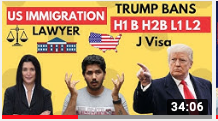 Each year, the U.S. Department of State permits hundreds of thousands of students to enter the U.S. and pursue their academic program. Below, we provide an overview of two popular student visa categories: F1 and J1.
Each year, the U.S. Department of State permits hundreds of thousands of students to enter the U.S. and pursue their academic program. Below, we provide an overview of two popular student visa categories: F1 and J1.
F1 vs. J1 Visa: Purpose
The F1 visa is available to qualifying international students who attend an academic or English Language Program at a college or university based in the U.S. Students holding an F1 visa must also maintain the minimum course load that is equivalent to full-time status.
The J1 visa is available to qualifying international students who are enrolled in recognized educational exchange programs (e.g. EAP, DAAD, AmidEast, Fullbright, LASPAU, etc.). The J1 visa is also available to full-time international students. However, most qualifying students apply for the F1 visa instead, since as described below the financial support requirements are lower, on-campus work opportunities are allowed, and they can take advantage of more or better post-graduate training options.
F1 vs. J1 Visa: Funding
Students petitioning for an F1 visa must show financial support for the first year of their program. The funding can be from any source (e.g. personal savings, loan from family member, etc.).
Students petitioning for a J1 visa must have at least 51% financial support from their respective academic institution, and demonstrate that they have financial support for the full length of their program.
F1 vs. J1 Visa: Work Eligibility
Students holding an F1 visa are eligible to work on-campus. Any off-campus employment opportunities require a work permit (which can typically be applied for via their institution’s International Student Office or directly from USCIS).
Students holding a J1 visa cannot work on-campus or off-campus, without first obtaining a work permit in conjunction with their employer (who must sponsor the employment opportunity).
F1 vs. J1 Visa: Additional Training/Professional Experience
Students holding an F1 visa may participate in Curricular Practical Training (CPT) for off-campus jobs or internships that are related to their course of study. They map also apply for post-degree Optical Practice Training (OPT) for 12 months (this may be extended for students in certain STEM majors).
Students holding a J1 visa may participate in up to 18 months of academic training during and after their studies. Those pursuing post-doctoral research may be eligible to extend this by up to 18 months. However, any off-campus work during the course of study reduces the available amount of academic training available (e.g. if a student is eligible for 18 months of academic training after graduation, but worked for 6 months during their studies, their training period would be reduced to 12 months).
F1 vs. J1 Visa: Dependents
Dependents (spouse and children) of an F1 visa holder may be allowed to join them in the U.S. on an F2 visa. F2 visa holders are not eligible to work in the U.S. They may, however, enroll in academic programs that are less than 1-year in duration from an approved school. Children holding an F2 visa may also attend elementary or secondary cool full-time.
Dependents (spouse and children) of an J1 visa holder may be allowed to join them in the U.S. per an J2 visa. J2 visa holders are eligible to work after obtaining a work permit, and can study part-time or full-time in the U.S.
Learn More
To learn more about the F1 and J1 visa, contact the Pollak PLLC team today. We will provide you with clear and accurate information. We’re here to help!
--
Karen-Lee Pollak is the Managing Attorney at Pollak PLLC located in Dallas, Texas. She is a frequent speaker, author and blogger on immigration issues. She can be reached at karenlp@pollakimmigration


-4.png)

